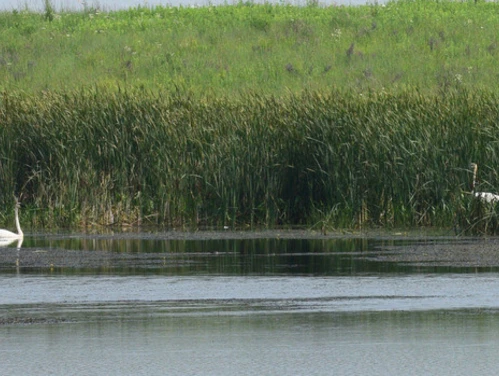Spring Run is one of the largest, most diverse complexes in the state, stretching from Hwy. 9 to the north to Lower Gar Lake to the southwest. The popular public wildlife area follows along almost the entirety of East Okoboji Lake.
Covering roughly 5,000 acres, the Spring Run complex was dedicated as Iowa’s second Bird Conservation Area in 2002, supporting less common bird species, including marsh wrens, black terns, American bitterns, dickcissels, grasshopper sparrows, bobolinks, northern harriers, upland sandpipers, trumpeter swans, and, most recently, nesting sandhill cranes.
With 200 natural and restored wetlands providing 1,300 acres of shallow lakes and marshes, Spring Run draws in the ducks and the waterfowl hunters.
“It’s the most popular waterfowl and birding areas in the state, walk in hunting is available as well as boat hunting on the larger areas,” said Chris La Rue, wildlife biologist with the Iowa Department of Natural Resources Great Lakes Wildlife Unit. “There’s a lot of local duck production here – primarily wood ducks, teal and mallards.”
Managing such an area takes a lot of work to keep the prairie in prairie and the shallow lakes and wetlands functioning properly. On the prairie, La Rue said they use prescribed fire multiple times in the spring with each fire covering 100-400 acres. Fire is Mother Nature’s way of reinvigorating the prairie and setting back trees and brush, which is important for grassland birds.
La Rue said the management plan also includes selected grazing on certain areas and a combination of food plots – corn, sorghum, millet and sunflowers – that are rotated annually. Habitat leases with local farmers help with the food plots and some land management practices, on a small scale.
The wetlands are managed by manipulating water levels to either encourage or knock back the vegetation, and that requires a functioning water control structure. Lily Lake Marsh, a 100-acre natural wetland on the complex, just had its water control structure replaced. La Rue said the marsh is currently full with the goal of reducing the cattails.
Nine additional wetlands totaling 30 acres are planned for an area that has been identified as a priority to reduce sediment and runoff to the lakes. The $350,000 wetland design and installation project is a partnership between the Iowa DNR and Ducks Unlimited and will be completed in 2026.
Construction is also underway on the Spring Run Shooting Range. The $400,000 renovation project began July 21 and is expected to be completed by late fall. When finished, the new range will offer a 15-foot tall earthen backstop with nine-foot tall side berms for a 30-yard and a 100-yard range; a series of steel baffles to contain projectiles and covered shooting structures for shelter along the firing line. Concrete sidewalks throughout the range will provide ADA access to firing lines as well as the firing lines for clay target shooting.
The complex adjacent to Elinor Bedell State Park and the Iowa Natural Heritage Foundation’s Narrows Preserve, which is being restored to its original prairie habitat.
The Narrows Preserve project is similar to the nearby Anglers Bay shoreline stabilization project that restored the oak savanna which allowed sunlight to return to the lakeshore, and aquatic plants to grow, adding protection to the shoreline and providing important fish habitat.
“This is a well-known, destination area,” La Rue said. “It has everything to offer from a recreation standpoint, but the most important is the water quality benefits to the Iowa Great Lakes.”
